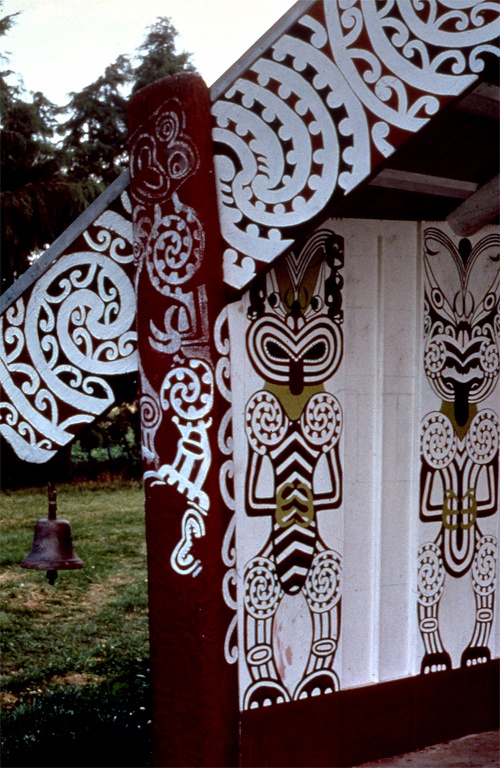
Rongopai (1887)
The image of a world in flux
From the late 1860s Māori turned increasingly to spiritual leaders rather than to warriors. The Ringatū Church, the most successful of the many new sects, was a typical fusion of Christianity and Māoritanga, inspired by Te Kooti’s conviction that the Māori were like the Israelites in Egypt. His followers adopted the carved meeting house as the centre of their worship and started a carved house-building programme.
Ironically, the best known of the Te Kooti houses is painted rather than carved. Rongopai at Waituhi was built to welcome Te Kooti but he never saw it because settler and Māori alike objected to him returning to the scene of his worst atrocities two decades earlier. The big (25.9 by 10.6 m) building of tōtara and pukatea pillars went up in just three months. It marked a sharp departure from tradition. ‘Old conservatives met youth, traditional practices met innovation, and the communal impulse met individualistic impulse, all in creative tension’, Lloyd Gretton wrote, observing that ‘the artists were expressing through their work their image of their own world in flux’.
Indeed, it is said that elders were so worried by the young artists’ exuberance and innovation that Rongopai, although used for Ringatū services, was placed under partial tapu for almost 80 years. By then it was almost on its last legs. Ringatū ceremonies had ceased long ago. Rongopai had been protected by an iron sheath earlier in the century and corrugated iron had replaced raupo thatching before the Second World War, but the old building was almost in ruins. Between 1967 and 1979 a new structure with concrete walls, a concrete floor and corrugated-iron roof was built to preserve it. The porch was extended by 2 m, new tukutuku panels were made to replace damaged ones, and the paintings were cleaned and restored. Now greatly treasured, Rongopai tells the story of a vibrant period of transition and in its innovative artwork it also provides an antecedent for Te Hono Ki Hawaiki, the equally innovative meeting house at the Museum of New Zealand (Te Papa) in Wellington.
Further information
This site is item number 64 on the History of New Zealand in 100 Places list.
Websites
- Te Kooti – NZ History
- Te Kooti biography – Te Ara
- Wiremu Pere biography – Te Ara
- Ringatū and Rātana – Te Ara
Book
- Roger Neich, Painted histories: early Maori figurative painting, Auckland University Press, Auckland, 1993


Community contributions